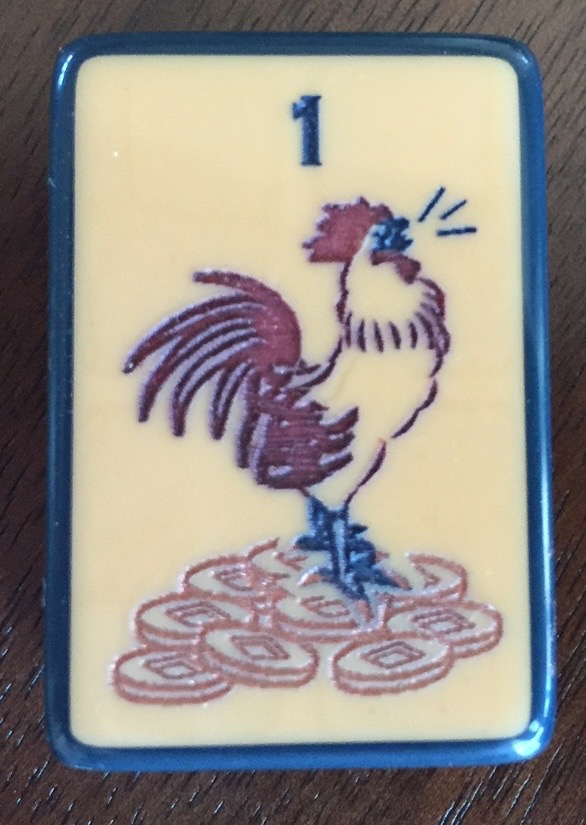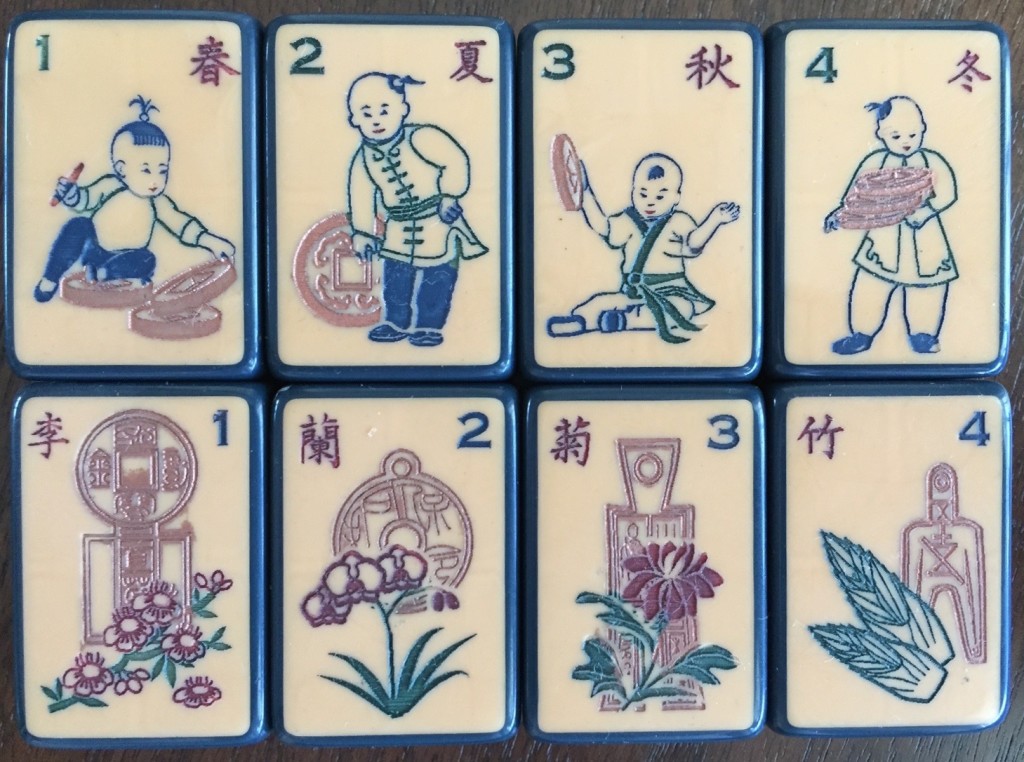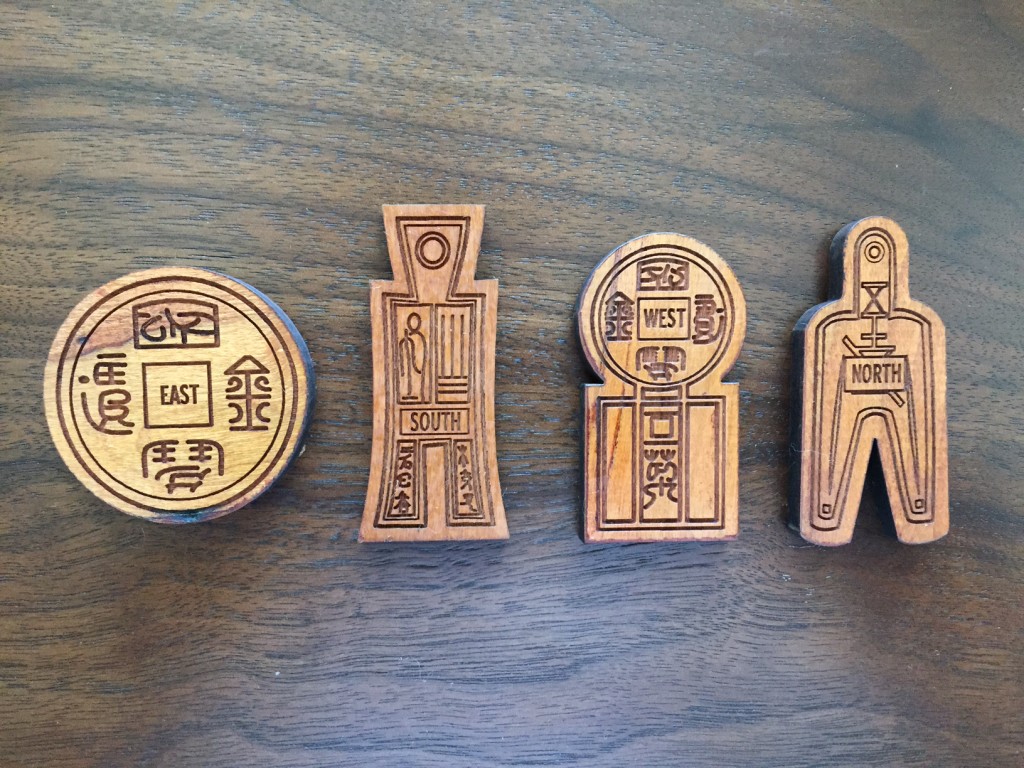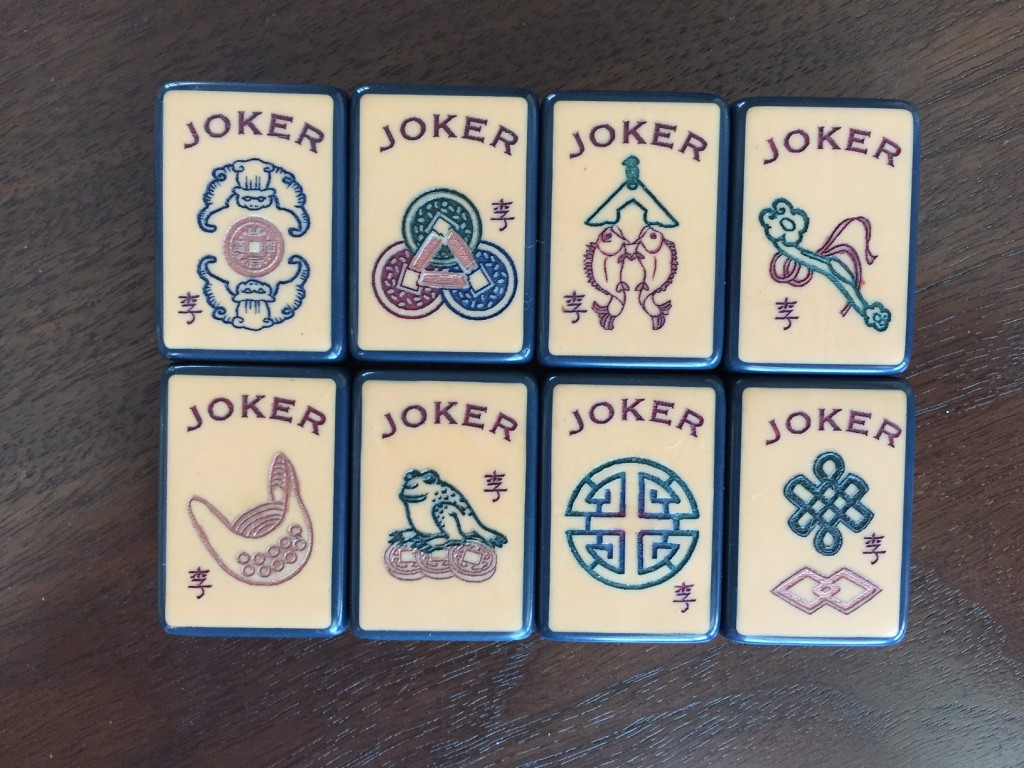I have given around 100 talks about mahjong art in the last year and a half, and I always mention the craftsmen who designed, carved and painted those tiles we all love. The other day I was asked about some of my favorite sets, and my thoughts immediately went to a wonderful one designed by Dee Gallo, a craftswoman! So here is a celebration of Dee and the beautiful sets she has designed. I am lucky enough to own one, featured today, but please visit her website to see some of the others.
Some of you know that when mahjong was ruled illegal in China, during the Cultural Revolution, all mahjong sets were ordered destroyed, as were all company records. Craftsmen were no longer allowed to practice the techniques that had been handed down for generations. Methods of carving, restoring, and painting Mahjong tiles were lost forever. Thank goodness Dee Gallo was determined to figure out how to bring tiles back to life, and I know many of us are indebted to her for her help restoring or replacing our lost tiles. But while learning how to go about restoring old tiles and carving replacement tiles, Dee was able to start thinking about creating new designs for sets. And this is her latest limited edition enrobed (!) set:
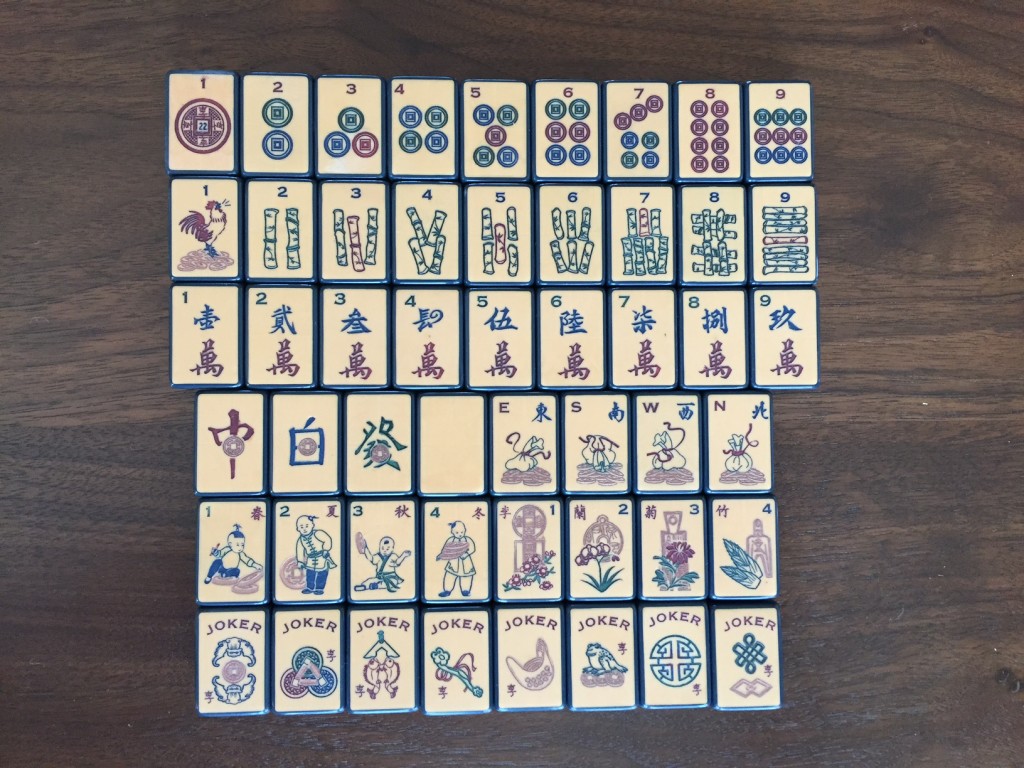
Dee's deep rooted knowledge of Chinese culture and history is evident in every new series she creates. Here you can see The Money Set, released in 2014. This is Dee's 8th set, dedicated to her parents. It pays homage to her grandfather and his two brothers who worked at the Bank of Shanghai. All three were sent to different parts of China to open bank branches, and they met their wives while working for the bank. Eventually they all decided to move to the United States and open their own banking business and fur import business. The banking world in China inspired Dee's latest set. (More about that later.) I know we all could not be more delighted that Dee is free to work on her creative designs on our shores.
I am going to use Dee's own words (in green) to describe what the images represent. But please visit Dee's site to really get to see the beauty of the tiles. My photos were taken with my cell phone, and don't begin to show the wonderful work she has done.
We'll start with the suits.
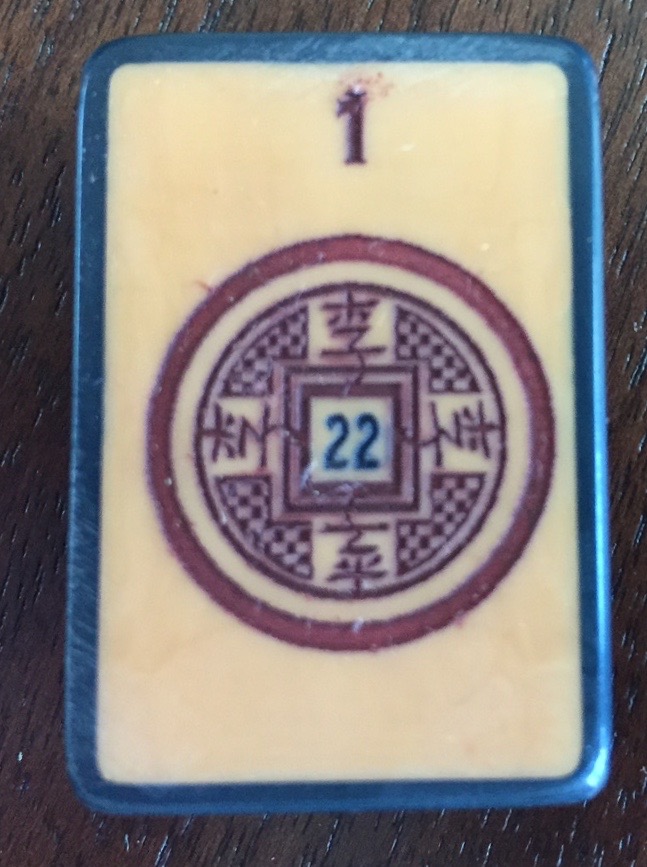
Dots:
"Each of the Dots in this set is a coin, with the #1 Dot sporting a signature and an edition number. The Chinese character for Lee, which is my family name, is rotated four times around the square hole, representing the four Cardinal points (E,S,W,N). Inside the square is the number representing its place in the series. Chinese cash is a symbol of prosperity, both as an amulet and an ornament. In 11th Century China, the name "round coin" was applied to copper coins (hence "Red Coin") (Ed, the name of Dee's business) described as "square within and round without." This represents the internal integrity of the government issuing the coin, and their external attitude of cooperation (no sharp corners to annoy anyone.) I hope to promote these qualities. Because this set celebrates the Chinese cash (coin) I have used copper as a color for the first time on many of the designs. (Ed: my husband Woody, an art director and font aficionado, noted that the typeface that Dee uses is Copper Plate, a lovely tie-in.)
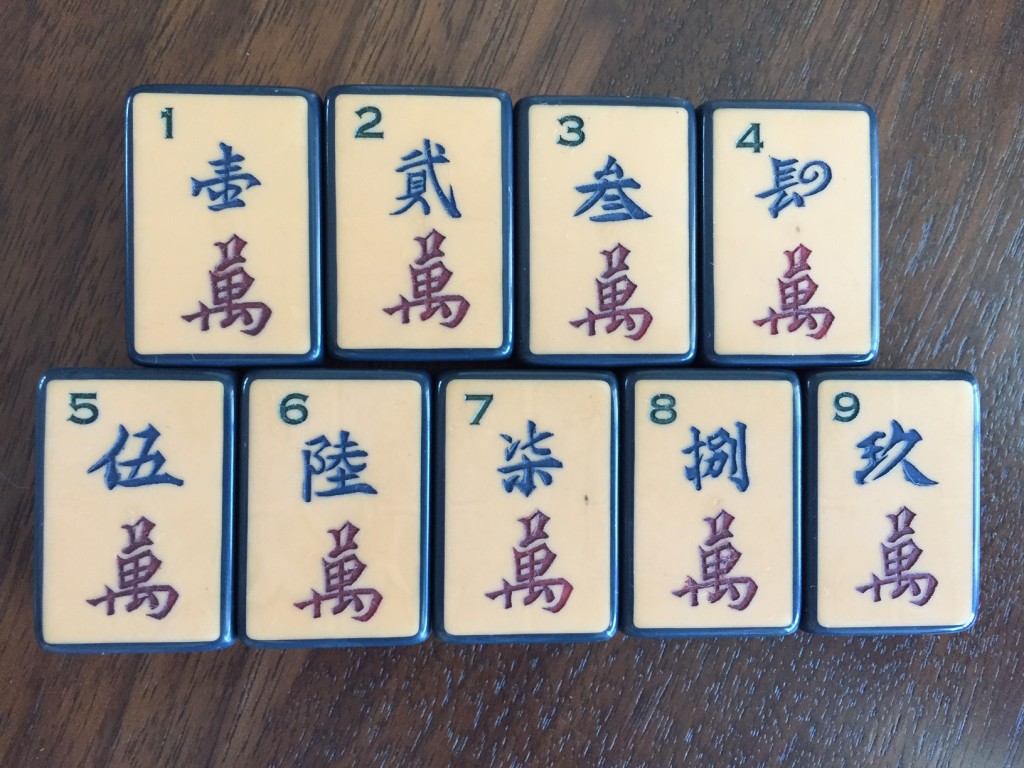
The Wan or Crak Suit
This is a unique suit designed with the special characters (ED: look at the Chinese numbers, very different from what we are used to seeing on our tiles) used in China and Taiwan for writing checks. The usual characters are too easy to alter so these characters were developed to make checks more secure. You can see the "normal" characters hidden in most of these special characters. These unusual characters are perfect for this Money Set, don't you think?
The Bamboo suit
The #1 Bamboo is my Rooster, perched on a pile of copper coins and crowing his joy at a prosperous day beginning. The Rooster has special meaning for me, as my father and sister were born in the Year of the Rooster and my husband's surname, Gallo, means rooster in Italian. So it is in their honor that I drew the Rooster as the #1 Bam, a distinctive tile in all Mah Jong sets. In addition, most of the rural villages in China had living bamboo fences surrounding the compound of houses, and plenty of chickens and roosters...these served as a security and early warning system against pirates and thieves.
(Ed: Be sure to look at the arrangement of the other Bams on this photo: some unique approaches to the designs!)
The Dragons
Coins decorate the Dragon suit as well. The Red (Jung) (Ed: sometimes written Chung) means "center" as in Jung Guo (China: central country). The Green (Fa) is half of the phrase "Fa Tsai," meaning (I hope you) become rich. The Blue character (Bai) means "white" or blank.
Ed: Don't you love the coin in each of the Dragons?
The Winds
Money bags represent the winds, with the neck of the bag facing in the direction of the tile. Each money bag is sitting on a pile of copper coins, representing abundant wealth and prosperity.
Ed: The money bags almost have personalities, don't they? They remind me of the first short made by Pixar: Luxo Jr. (If you are not familiar with this short, you will have to go to youtube to see that delightful film: search for Luxo Jr. I was not allowed to post the link here.)
The Flowers
One set of Flowers sports a large coin and as flower representing the season. The large coins are indicative of the traditional shapes used for coins in early dynasties. The characters tell you the name of the plant, 1 Plum, 2 Orchid, 3 Mom (Ed: chrysanthemum) 4 Bamboo. th other set of Flowers depicts children playing with coins in each season (1 Spring, 2 Summer, 3 Autumn, 4 Winter), representing a wish for prosperity and luck.
Ed: In the top row I believe Dee is paying homage to 100 children, a theme often seen in Chinese art, where children are seen being children in paintings. Children are also seen on mahjong tiles and boxes
Direction Coins
(Ed: Dee made these specifically for this set. As many of you know, we often find mings with direction coins in our old boxes, or sometimes a bakelite wheel indicating directions on it. Dee designed her own, also seen on the top row of the Flower tiles.)
Jokers
(Ed: sadly I only have eight Jokers, but I will tell you about all of them, and you just will have to go to Dee's website to see them all)
Each joker shows a design which will bring you luck and prosperity!
2 Facing Bats and coin: Blessings before your eyes
3 Coins tied together: the Trinity of luck-Heaven, Earth and Mankind
Double Fish & Stone Chime: May you have a superabundance of auspicious happiness
Ruyi: Wish-granting Wand, Ruyi means "As you wish"
Ingot: Yuanbao is a large ingot of gold representing the phrase "all will be as you wish" in addition to prosperity
3 legged Toad: Belongs to Liu Hai, God of Wealth & always finds gold
Shou Medallion: the longevity symbol, when used in a circular shape mens fulfillment or completion. Mah Jong!
Lozenge and Endless Knot: may you have everlasting victory for 10 Thousand generations
I am missing ( 🙁 )
Yin-Yang: Remember there is a balance in life, you win some, you lose some! This symbol is actually called Tai-ji, meaning The Original One, from which the duality of Yin (dark)/Yang (light) developed.
5 Ears of Grain on One Stalk: may you enjoy a bumper harvest and reap a big reward!
Now, wasn't this a wonderful treat? Here's to Dee!!

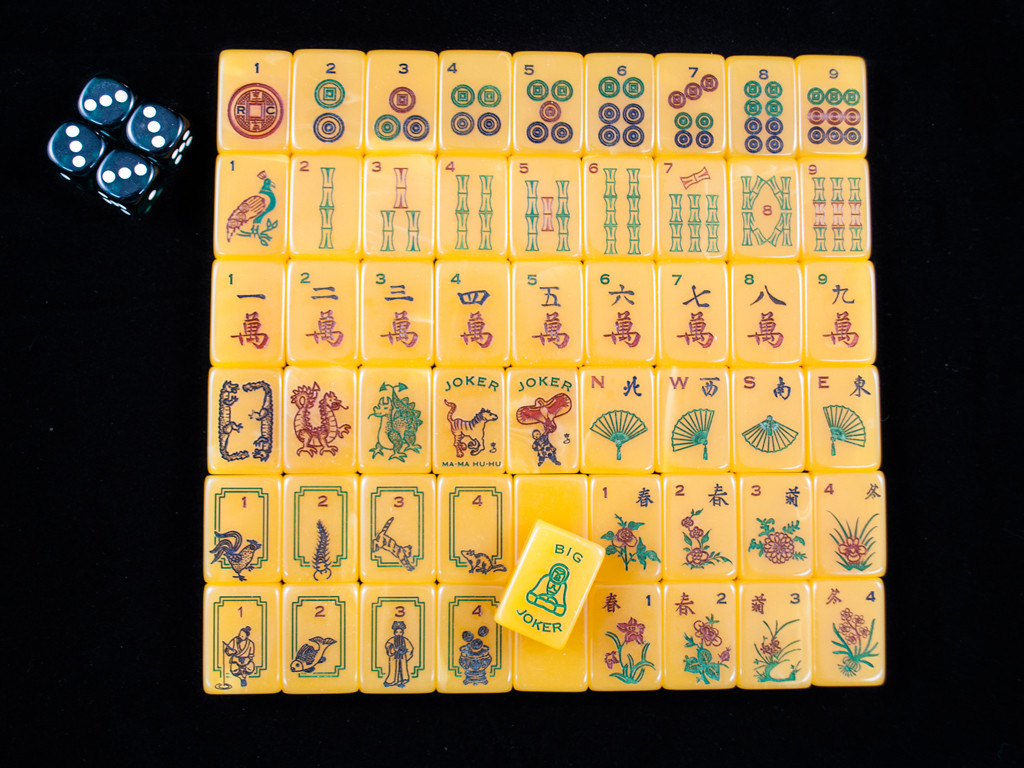
You have a chance to buy one of Dee's other sets, designed by Dee and the people at Crisloid. (Click here.)The Dragon Set takes many of Crisloid's unique designs and combines them with Dee's images.

